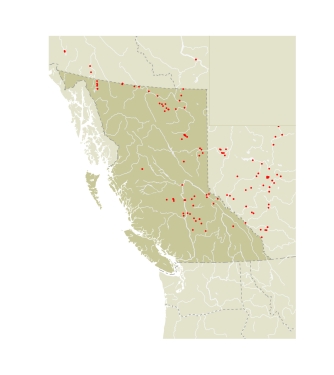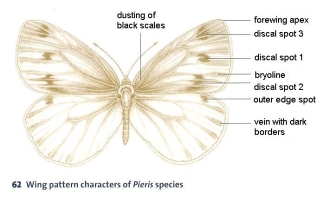Mustard Whites are displaced by Cabbage Whites where Cabbage Whites invade their habitat, resulting in a greatly reduced distribution of Mustard Whites in eastern North America (Scudder 1889b). Mustard Whites were common in Nova Scotia in 1864 (before the arrival of Cabbage Whites), but were uncommon and local by 1954 (Ferguson 1954). The mechanism of the displacement is unknown, but it may be similar to the extirpation of Viceroys from BC and northern Washington. Since cultivated cabbage crops are used where available, they may become the dominant oviposition sites for Mustard White populations near human habitation. Pest control for Cabbage Whites may result in the extirpation of the bivoltine to trivoltine Mustard Whites, while the multivoltine Cabbage Whites survive. The distribution and abundance of Mustard Whites probably increased greatly early in European settlement of eastern North America, before the appearance of Cabbage Whites, because of the introduction of crops of cabbage, turnips, radishes, and other Brassicaceae.
Mustard White biology in eastern North America has been summarized by Shull (1977). Females have a much greater probability of dispersing from the main colony area than males, and dispersing females frequently lay eggs on larval foodplants not normally used. Females can apparently detect the odour of the larval foodplants when flying nearby, even when the plant is hidden under other vegetation. When larval foodplants are common, a female lays only one egg on a plant before moving on; when the plants are rare, she may lay more than one egg on the same plant. Mustard Whites are trivoltine across temperate North America, according to Scudder (1889b), and in BC they are at least bivoltine.
The larval foodplants are all in the family Brassicaceae. Mustard Whites normally utilize native species such as Arabis and Dentaria species that grow in open forest, but cultivated Brassicaceae were utilized in the absence of competition with Cabbage Whites. The larvae that produced the type series of the species were found on turnip, cabbage, and radish (Harris 1829), and Mustard Whites were a pest on cabbage and radish in gardens in Newfoundland in the early 1830S (Gosse 1883). Harris (1862) reported that "about the last of May, and the beginning of June, it [the Mustard White] is seen fluttering over cabbage, radish, and turnip beds, and patches of mustard, for the purpose of depositing its eggs ... I have seen these butterflies in great abundance during the latter part of July and the beginning of August, in pairs, or laying their eggs for a second brood of the caterpillars." Thus for most of the 19th century Mustard Whites were an economic pest in eastern North America, only to be displaced by the Cabbage White.
Near Quesnel, BC, Mustard Whites use Arabis species. Outside BC other larval foodplants include Arabis drummondii, A. perfoliata, Barbarea vulgaris, Cardamine pratensis, C. flexuosa, Oentaria, Nasturtium armoracia, Rorippa nasturtium-aquaticum, and Sinapis (Scudder 1889b; Shull 1977; Chew 1980). Eggs laid on introduced garlic mustard in New England result in larvae that sometimes successfully mature and sometimes die (Courant et al. 1994).
|

